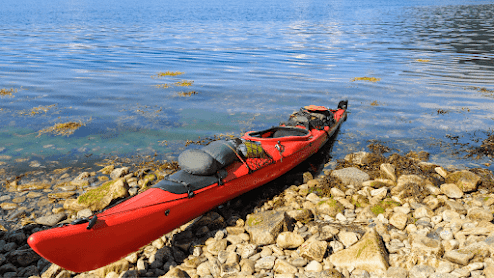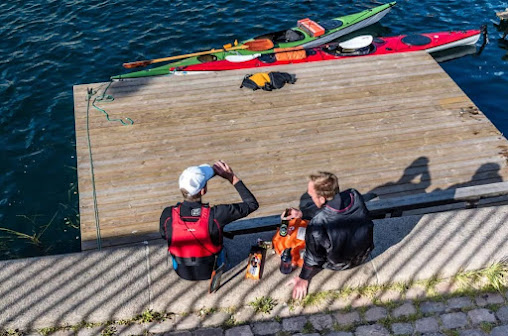Safety rules when traveling in a kayak
Kayaking is an extremely enjoyable way to spend leisure time in contact with nature. Canoeing on rivers will be safe, as long as we act sensibly and follow a few basic rules.
Preparing for a safe rafting trip
In order to
make a canoe trip safe even before you set out, you need to take care of a few
things.
Choose the right route
When
choosing a rafting route, adapt it to your own skills and those of the people
you are rafting with - family, friends, and acquaintances. Consider the least
experienced participants.
To choose a
good canoe route, get some information about the river you intend to canoe.
What is the level of difficulty of each section? Are there windmills, weirs,
rapids, and other obstacles on the river that require experience to overcome?
You should
also plan your route to finishing before dark. Swimming in the dark is dangerous.
It is very difficult, if not impossible, to render assistance in such
conditions.
Before
rafting, it is a good idea to get a guidebook or map. I recommend contacting a
canoe rental company directly on the river you intend to canoe. They should
also be able to tell you which route will be best for you. Shorter and easier
for beginners? A little longer for families with children? Or perhaps a more
challenging one with obstacles for experienced kayakers?
Also, read How to prepare for kayaking - Tips for beginners.
Check the weather
Before you
set sail, always check the weather forecast for the coming hours and adjust
your clothing to the weather conditions. Never go out during high winds, heavy
rain, or thunderstorms. While rafting, keep an eye on weather changes. If you
see rain or storm clouds approaching, abort your rafting trip.
Pack the essentials
Space in a
kayak is limited, but even on a short trip, we should take a few essentials to
ensure our safety. Among them are:
- an adequate amount of drinks - for a rafting trip of several hours at least 1.5 liters per person,
- dry provisions - sandwiches, fruit, high-energy bars, or other favorite snacks,
- first aid kit,
- sunglasses and UV sunscreen (especially on hot, sunny days),
- a spare set of dry clothes,
- a wet-proof cell phone with a charged battery,
- phone number of the rafting organizer/rental owner.
Always swim with a vest
Even if you
are a good swimmer, wear a safety vest when traveling in a kayak. It must be
properly fastened and snug against your body. Do not use it as a padded
backrest on a rigid seat in a kayak. For children and people who feel unsafe on
the water, it is mandatory to wear a safety vest. In case of sudden cold, rain, or wind, a waist vest will also provide an extra layer of protection against
the cold.
Your kayak rental company should supply you with safe, approved life jackets for adults and vests for children.
Selection of settlements
Participants
in a canoeing trip often present varying degrees of skill when it comes to
kayaking. Therefore, before a canoe trip, it is important to properly select
the settlements - that is, the canoe crews.
Here are
the basic rules to follow in two-person kayaks:
- people with no kayaking experience should not go in one kayak,
- beginners and less experienced people should sail with a person with more experience,
- people who cannot paddle or swim poorly should sit in a kayak with a person who is comfortable in the water,
- a heavier person should sit at the back so that the bow of the kayak rises slightly upward,
- children under 15 should go with an adult who can swim.
- If sailing in single-person kayaks, less experienced people should sail in formation between those with more experience.
Beginners
or those with little experience should have a short training session before
sailing. Practice getting in and out of kayaks, how to paddle forward and
backward, how to steer the kayak, and learn how to avoid obstacles, and how to
behave in emergency situations, such as when the kayak capsizes.
Don't drink alcohol
Under no
circumstances should you go kayaking while under the influence of alcohol or
intoxicants. This is irresponsible and can end in tragedy. On a kayaking trip,
it is common to have to react instantly and make quick decisions, and alcohol
increases reaction time. It also triggers a tendency toward risky behavior and bravado,
which is especially dangerous on the water. On hot days, drinking alcohol
further exposes the body to dehydration. On cooler days, it certainly won't
warm us up, and we can only overcome ourselves.
Safely in a kayak
When
kayaking, special care should be taken when getting in and out of a kayak. This
is when most capsizes happen. When getting into the kayak, position it to parallel
to the shore, with the bow upstream. It is a good idea to choose a place where
the water is relatively shallow. When getting out, also position it against the
current. This is easier and safer.
In a flowing kayak:
- do not try to squat or stand up - the body's center of gravity must be located very low above the water,
- do not sit on the sides, bow, and stern, sit only in the cockpit,
- do not jump from the kayak into the water,
- do not swing the kayak from side to side or make other sudden movements,
- do not push off other kayaks with your paddles - this risks capsizing or damaging the kayaks,
- do not run into the kayaks of other canoeing participants,
- do not let the paddle out of your hand.
If you have
to get out of the canoe into the water do it always in shoes. There may be
sharp stones or branches lying on the river's bottom.
You may also be interested in the article - Best Inflatable Kayak For Whitewater.
Safety during rafting
Swimming formation
When
getting into the kayaks, we should determine the swimming formation, i.e. the
order in which the various settlements get down on the water and cover the
chosen section.
We should
try to have experienced kayakers who know the river in the first and last crew.
All other settlements are between the leading and closing canoe. The leading
settlement regulates the pace, shows the other settlements the way to swim,
informs about obstacles, and belays difficult or dangerous places. It is not
allowed to overtake it. Behind it should sail the settlement with the least
aquatic experience. The last crew closes the formation and makes sure that no
one is left behind or gets lost. She also usually carries a first aid kit.
The
distances between successive kayaks should be adapted to the nature of the
particular section of the river and to the skills of the crews. It is best to
keep a distance of about 10-20 m so that you always have in sight the crew
ahead and behind you.
Watch the water's surface
When
cruising on a river, watch the water surface in front of your kayak. Pay
attention to eddies in the current and any wrinkles on the surface. They are
indicative of various underwater obstacles, such as a stone, a stump, or shallow water, which can threaten to capsize the canoe. It is necessary to
avoid them at the right moment.
Obstacles and dangerous places
On our
route, there may be obstacles over the water - low footbridges, overhanging
branches, or fallen trees, the so-called heaps. Swim under them slowly, leaning
forward, and keep your paddles against the canoe, along its hull. You can help
yourself with your hands by pushing off from trees, branches, or river banks.
Under low footbridges, try to swim where there is the greatest distance between
the surface of the water and the bottom of the footbridge.
Never kayak
through dangerous places - half-sunken logs, visible eddies, sluices, weirs,
steps, and concrete water thresholds going across the river. In such cases, get
ashore and carry the canoe overland to the other side of the obstacle.




Комментарии